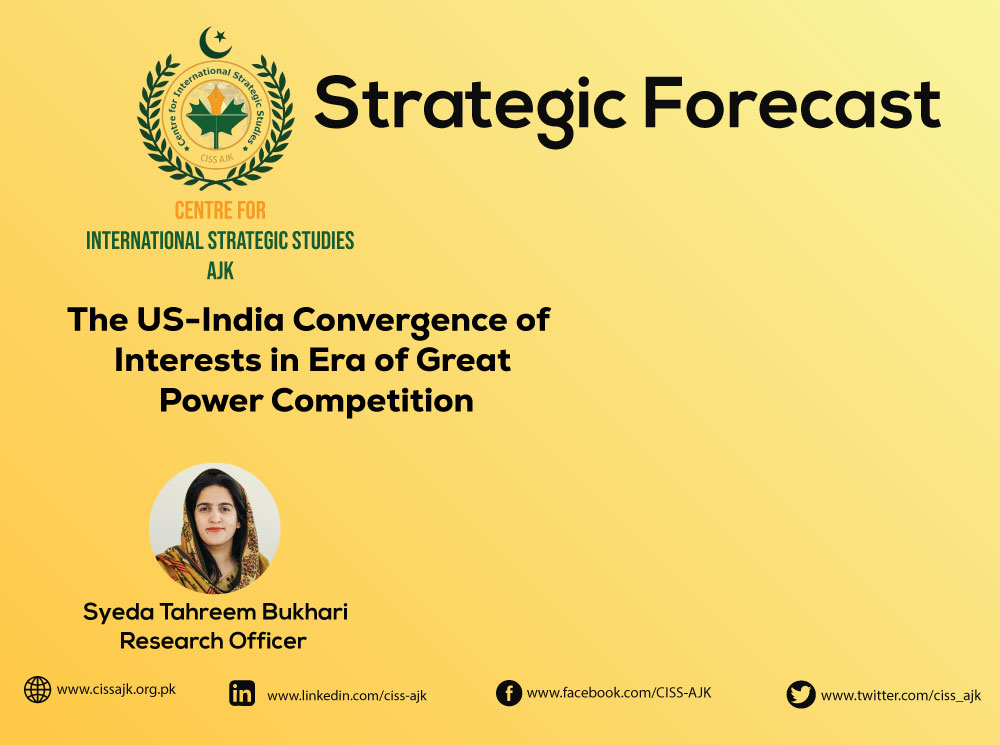Narendra Modi who was denied visa to the US due to his role in master minding the Gujarat genocide in which Hindu mobs torched Muslim homes, killed Muslim men, women and children, and erased mosques and graves. Now the same US, which was once the torch bearer of human rights and rule based international order has put its stature into question in this era of great power competition where the US interest to maintain status quo superseded the principles and values it anchored.
The shift of great power competition in Asia-Pacific has brought the US and India together to counter the rise of China. The US in its National Defence Strategy 2022 adopted integrated deterrence approach to counter the competitors. It involves integrating the capabilities of key allies in all domain. The US initiated the strategic agreements with its key allies to strengthen them in achieving its objective. In this regard, the interest of the US and India are converged. India perceived China as an obstacle in achieving its regional hegemonic ambitions so that it presents itself as major player in Asia-Pacific that will facilitate the US in countering China. They are involved in strategic engagements that cover wide areas from defence cooperation, satellite imagery, cyber, artificial intelligence to critical emerging technologies. The recent visit of Narendra Modi to the US came to an agreement on a long list of deliverables spanning defence, critical and emerging technology, and space cooperation that will boost the US-India strategic relations.
Narendra Modi secured the deal of fighter jet engines GE-414 in his visit, according to this agreement General Electric will jointly manufacture engines with Hindustan Aeronautics Limited. Only four countries (US, UK, Russia, and France) have this technology so far while China has achieved much by reverse engineering Russian jet engines. This deal is going to serve India’s ambitions of military modernization and Atmanirbhar Bharat campaign initiated by Modi. India is going to use these engines to power Tejas, MK2, and fifth generation Advance Medium Combat Aircraft. India is diplomatically gauging the maximum benefits from the US-China competition. It is also maintaining its trade relations with Russia despite economic sanctions imposed on Russia by the US.
To counter economic dependence on China, the US is investing in semiconductors in India making another Semiconductor Centre there for commercial and innovation purpose to diversify the supply chain. The US has renewed visa policy for Indian workers. They are collaborating on space program as well. India has joined the US-led Artemis Accords on space exploration. Also, India’s space agency ISRO will work with NASA towards a joint mission to the International Space Station in 2024.
The US obsession with countering China is evident from the US tilt towards India. The US holocaust museum project ranked India 8th among 162 countries for the highest risk of mass killing. The US commission for International Religious Freedom, since 2020, has advised the State department to put India on black list over its record. Moreover, Religious Freedom Report 2022 of US department notices the rise of very troubling trends in India such as targeted attacks against religious minorities. The US so far has maintained the status of preserving rule based international order but its persona under the strategic engagements with India is questioned. The gross violation of human rights is rampant in India under the BJP government where minorities are targeted indiscriminately Manipur is burning, Kashmiris are victim of state-sponsored terrorism. The social fabric for minorities is shrinking. To preserve the status quo, the US is disregarding human rights violation in India and also overlooked the outcomes of its engagements with India on South Asian region. It is sharing critical emerging technologies with India, instilling security dilemma in the regional states endangering the stability of entire region. The US-India engagements are creating asymmetry, threatening the strategic equation of South Asia making it prone to strategic miscalculations.
Author is a Research Officer at the Center for International Strategic Studies. She tweets @Tehmii_Syed.


